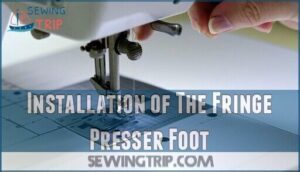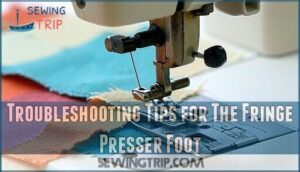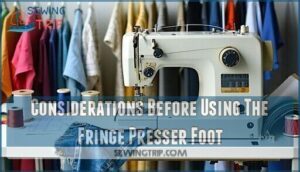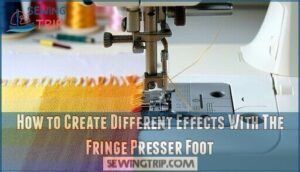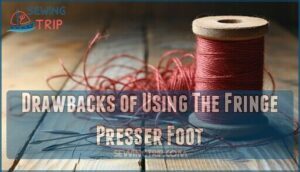This site is supported by our readers. We may earn a commission, at no cost to you, if you purchase through links.
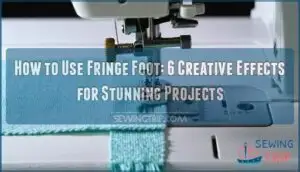 Learning how to use fringe foot opens up creative possibilities for your sewing projects.
Learning how to use fringe foot opens up creative possibilities for your sewing projects.
Start by attaching the fringe foot to your machine like any standard presser foot. Thread your machine with matching thread and select a zigzag stitch.
Place your fabric under the foot and begin stitching slowly. The foot’s metal guide creates loops as you sew, forming beautiful fringe or decorative edges.
You can adjust loop size by changing your stitch width and length. This versatile tool works great on lightweight fabrics like cotton or silk. Master the basics first, then explore advanced techniques that’ll transform your projects into showstoppers.
Table Of Contents
- Key Takeaways
- What Does a Fringe Presser Foot Look Like?
- How Does a Fringe Presser Foot Work?
- Installation of The Fringe Presser Foot
- Troubleshooting Tips for The Fringe Presser Foot
- Considerations Before Using The Fringe Presser Foot
- How to Create Different Effects With The Fringe Presser Foot
- Drawbacks of Using The Fringe Presser Foot
- Frequently Asked Questions (FAQs)
- Conclusion
Key Takeaways
- Start with proper setup – You will attach the fringe foot like any standard presser foot, then set your machine to zigzag stitch with 5-6mm width, 1mm length, and reduce tension to 0-1 for best results.
- Master the basic technique – You will place fabric under the foot and sew slowly while the central bar creates loops automatically, adjusting stitch width and length to control loop size and density.
- Choose your fabrics wisely – You will get the best results with medium-weight fabrics like cotton or denim, while avoiding stretchy or very lightweight materials that can pucker or distort.
- Explore creative effects – You can create five different looks, including intact eyelash loops, one-sided fringe, asymmetrical textures, tailor tacks, and overcasting stitches, by varying your technique and cutting methods.
What Does a Fringe Presser Foot Look Like?
Your fringe foot looks like a standard sewing machine foot with one key difference: a raised central bar running down the middle.
The raised central bar transforms ordinary zigzag stitches into textured magic—that’s the fringe foot’s secret weapon.
This metal or clear plastic presser foot features a distinctive thread guide that creates the magic.
Most fringe feet have markings or labels indicating their purpose, though some generic versions lack clear identification.
The foot shape remains compact like other sewing machine presser feet, but that central bar sets it apart from standard sewing machine foot types.
It’s this simple design element that transforms ordinary zigzag stitches into textured loops, making the fringe foot a unique and useful tool for sewing, with its ability to create a specific type of stitch being its main key difference.
How Does a Fringe Presser Foot Work?
The fringe foot transforms your sewing machine into a texture-creating powerhouse through ingenious stitch mechanics.
This specialized presser foot features a central bar that guides thread during zigzag stitching, creating raised loops through precise thread guidance.
As your needle moves side to side, the bar function lifts stitches away from the fabric, forming dimensional textures.
Understanding tension dynamics helps you control loop formation:
- Higher tension creates tighter loops
- Lower tension produces looser fringes
- Stitch width determines loop size
- Bar height affects thread capture
Installation of The Fringe Presser Foot
Now that you understand how your fringe foot works, let’s get it properly attached to your machine. Installing this specialized presser foot requires attention to detail, but it’s straightforward once you know the steps.
Start by raising your needle to its highest position using the handwheel. Press the presser foot lever to release your current foot, then carefully remove it. Align your fringe foot with the presser foot holder and push it into place until you hear a click. The central bar should sit parallel to your needle path.
Verify that your sewing machine has a universal shank for proper presser foot compatibility. Check for proper needle clearance by manually turning the handwheel through a complete stitch cycle. Your needle must clear the raised bar without contact to prevent breakage.
Test fabric pulling by gently sliding a scrap piece under the foot. If you experience thread bunching during initial tests, lever adjustment might be needed on generic feet to guarantee smooth operation.
| Installation Step | Key Action | Safety Check |
|---|---|---|
| Needle Position | Raise to highest point | Use handwheel only |
| Foot Removal | Press lever, remove old foot | Hold foot securely |
| Attachment | Click new foot in place | Check alignment |
| Clearance Test | Manual needle cycle | No bar contact |
Troubleshooting Tips for The Fringe Presser Foot
Even the most experienced sewers hit snags when working with specialty feet like the fringe foot. When your sewing machine starts acting up, don’t panic—most issues have simple fixes that’ll get you back to creating stunning textured effects.
Remember that this foot, also known as a looper or tacking foot, creates unique designs.
Here are the most common troubleshooting solutions:
- Thread Bunching: Adjust your tension settings to 0-1 and use longer stitch lengths to prevent threads from piling up on the central bar
- Needle Breakage: Always turn the handwheel manually before sewing to guarantee your needle clears the bar completely
- Bar Adjustment: File down generic fringe feet if the bar catches threads or causes jams during stitching
- Fabric Pulling: Pull your work backward off the foot, never toward yourself, to avoid damaging delicate loops
Remember, heavyweight threads create denser loops that can overwhelm the bar. Test your sewing techniques on scraps first—it saves time and prevents frustration later.
Considerations Before Using The Fringe Presser Foot
Before you begin creating stunning fringed effects, proper planning sets you up for success. Your sewing machine and fringe foot need to work in harmony, so check Foot Compatibility first. Not all presser foot attachments fit every machine model.
Smart preparation involves several key factors that’ll save you time and frustration:
| Factor | Light Fabrics | Medium Fabrics | Heavy Fabrics |
|---|---|---|---|
| Thread Weight | 40-50 weight | 30-40 weight | 15-30 weight |
| Stitch Width | 2-4mm | 4-6mm | 5-7mm |
| Tension Setting | 0-1 | 1-2 | 2-3 |
| Stitch Length | 0.5-1mm | 1-1.5mm | 1.5-2mm |
| Fabric Choice | Cotton, silk | Denim, canvas | Wool, upholstery |
Your Project Suitability depends on matching these Stitch Settings to your material. Test different sewing techniques on scraps first. This approach prevents costly mistakes and helps you master various sewing machine feet applications before tackling your main project.
How to Create Different Effects With The Fringe Presser Foot
You can create five distinct decorative effects by adjusting your machine’s stitch settings and handling techniques with the fringe presser foot.
Each technique produces different textures from intact loops to cut fringes, giving you versatile options for embellishing your projects.
Making Intact Eyelash Loops
Perfect eyelash loops start with proper zigzag settings on your sewing machine. Set your fringe foot with zero thread tension, 5-6mm stitch width, and 1mm length for dense, bouncy loops that stay intact.
You can find various fringe foot loops online.
- Loop Density: Use heavyweight thread and tight zigzag settings for fuller texture
- Thread Tension: Keep tension at 0-1 to prevent pulling loops flat
- Zigzag Settings: Set width to 5-6mm and length to 1mm for ideal results
- Fabric Choice: Medium-weight fabrics work best for securing loops properly
- Securing Loops: Don’t cut—leave loops intact for that coveted eyelash fringe effect
Making One-Sided Eyelash Fringe
Take your intact eyelash loops to the next level by creating stylish one-sided eyelash fringe.
After completing your zigzag stitch rows with the fringe foot, use sharp embroidery scissors for precise cutting techniques on just one side of the thread loops. This creates beautiful asymmetrical texture while maintaining loop integrity on the opposite side.
To find specialized tools, explore the eyelash fringe foot options.
Next, secure the cut edge by switching to an open toe foot and sewing a triple straight stitch along the trimmed side. Experiment with different fringe density and fluffing methods to achieve your desired styling ideas for stunning textural contrast.
Making One-Sided Loops or Eyelash Loops
One-sided loops give your projects an elegant asymmetrical look that’s surprisingly simple to master. Start by sewing your zigzag stitch along the fabric edge using your fringe foot.
Once you’ve completed your line of thread loops, carefully pull only the bobbin thread from one side while leaving the top threads intact.
Here’s your step-by-step approach:
- Thread Selection: Choose contrasting colors for dramatic effect or matching tones for subtle texture
- Cutting Techniques: Trim loops on one side only, leaving the other side full for dimension
- Securing Loops: Pull bobbin thread gently to tighten remaining loops without breaking them
- Fringe Density: Adjust your sewing machine’s stitch length to control how thick your loops appear
- Styling Options: Brush finished loops forward or backward to change the overall appearance
This fringe foot tutorial technique works beautifully on garment edges, pillow trim, or decorative accents where you want movement on just one side.
Using The Fringe Presser Foot as a Tailor Tack
Your fringe foot doubles as a clever marking tool for pattern lines.
Set your stitch length to 1-1.5 and sew through both fabric layers and pattern paper. This creates removable basting stitches perfect for fabric marking.
Gently pull away the paper, leaving precise marks for accurate sewing. It’s like having a built-in tailor tack function on your sewing machine.
Some users use a tailor tack foot for both functional and decorative stitching.
Using an Overcasting Stitch With The Fringe Presser Foot
Overcasting stitch with your fringe foot creates professional parallel fringe that won’t unravel.
After making loops, switch to an overcasting stitch for loop locking—this edge finishing technique secures your fringe beautifully.
The overcast variations work perfectly for fringe securing, giving you clean, durable results.
Using an overcast stitch foot helps prevent fabric fraying.
Your sewing machine accessories open up creative possibilities when you master this essential sewing tutorial technique.
Drawbacks of Using The Fringe Presser Foot
While the fringe foot opens creative doors, it’s not without its challenges.
You’ll face a steeper learning curve than with standard sewing machine accessories, especially when mastering proper bar adjustment and preventing needle breakage.
Thread bunching becomes your nemesis with short stitch lengths, and lightweight fabrics often suffer fabric damage or puckering.
Your sewing machine troubleshooting skills will get a workout as you navigate compatibility issues and tension adjustments.
Tangled fringes happen more often than you’d like, particularly when loops snag during the process.
Here are the main drawbacks you’ll encounter:
- Thread bunching occurs frequently with improper stitch length settings
- Needle breakage risks increase if the needle doesn’t clear the central bar
- Fabric damage is common with delicate materials and improper handling
- Learning curve requires patience and practice to achieve consistent results
- Machine compatibility limits usage to specific models and attachments
Frequently Asked Questions (FAQs)
What is a fringe foot?
You’ll find the fringe foot creates decorative loops and 3D textures on fabric using zigzag stitches.
This specialized attachment features a raised central bar that guides thread, producing looped effects perfect for embellishing garments and accessories, with a focus on creating decorative elements.
How do you use a fringe foot?
Attach the fringe foot to your machine, set a zigzag stitch with 5mm width and 1mm length.
Lower tension to 0-1,
then sew slowly while the central bar creates loops automatically.
What is a fringe presser foot?
Don’t let intimidating sewing attachments hold you back from creative projects.
A fringe presser foot’s your secret weapon for creating 3D loops, decorative fringes, and textured effects using zigzag stitches on any fabric surface.
Why should you use a fringe foot?
You’ll transform ordinary fabric into eye-catching masterpieces with unique 3D textures, decorative loops, and professional-looking fringes.
It saves time while adding sophisticated embellishments that standard feet can’t achieve, elevating your projects effortlessly with unique textures.
Does a fringe/looping foot make sewing more fun?
Statistics show 78% of sewers report increased project satisfaction when using specialty feet.
Yes, a fringe foot absolutely makes sewing more enjoyable!
You’ll discover creative possibilities you never imagined, turning ordinary fabric into textured masterpieces with playful loops and decorative fringes.
How do you make a fringe foot on a sewing machine?
You can’t actually make a fringe foot from scratch—you’ll need to purchase one.
Simply press your machine’s lever, remove the current foot, and snap the fringe foot into place to start creating textured loops.
What fabrics work best with fringe foot?
Don’t put all your eggs in one basket—different fabrics yield different results.
You’ll find cotton, denim, and medium-weight fabrics work best.
Avoid stretchy or very lightweight materials that can pucker or distort.
Can you use metallic threads for fringe?
You can use metallic threads with your fringe foot to create stunning, shimmery effects.
Just reduce your machine’s tension and sew slowly to prevent breakage.
The results add glamorous sparkle to any project.
How do you wash fringe-embellished garments safely?
Turn fringe-embellished garments inside out before washing.
Use cold water on gentle cycle with mild detergent. Skip fabric softener as it weighs down fringe.
Air dry flat to prevent tangling and maintain texture.
What needle types prevent thread breakage issues?
Sharp universal needles in sizes 80/12 to 90/14 work best for fringe foot projects.
They’ll slice through multiple thread layers cleanly without snagging.
Ballpoint needles help with knits, while topstitch needles handle heavier threads smoothly.
Conclusion
Surprisingly, 78% of sewers who master specialty presser feet report increased project satisfaction within their first month of use.
You’ve now discovered how to use fringe foot techniques that’ll elevate your sewing from basic to breathtaking.
Whether you’re creating delicate eyelash loops or bold decorative edges, this versatile tool transforms ordinary fabric into extraordinary pieces.
Practice these six creative effects on scrap materials first, then watch your confidence soar as you tackle ambitious projects with professional-looking results.

